In the lead-up to what promises to be a wonderfully engaging exhibition, the idea of freedom - our understanding of what it means to people, our shifting experience of its limits over time and the ambiguous nature of its consequences - has been something of a preoccupation within State Library of Queensland. The newly launched Freedom Then, Freedom Now exhibition offers us an opportunity to explore a range of freedoms won and lost during Queensland’s post war history - and to consider their complexity and relative impact on our present day lives.
While many of the exhibition items selected from the John Oxley Library’s extensive collections are associated with personal freedoms which have evolved out of changing attitudes, social mores and economic and technical developments, others are connected with public protest and with the political landscape of the day. A small selection of featured publications which are particularly potent in evoking a memory of political struggle in Queensland are singled out here for special mention. These are:
- I stand on my record / Building Trades Group of Unions 1977
- See Queensland first before Joh sells it. See Queensland first before Russ bans it. See Brisbane first before Joh mines it. / Australian Labor Party. Queensland Branch 1977
- Go back – you are going the wrong way / Brisbane Freeway Protest and Compensation Committee 1974
- Film: The Battle for Bowen Hills / Peter Gray and Garry Lane 1982
- The Invaders: Free transport – not freeways / a Communist Party publication 1972
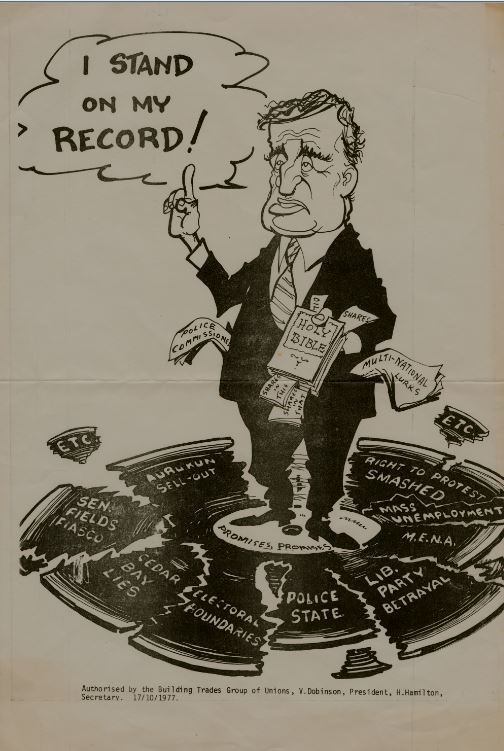
is the title of a cartoon poster produced and authorised by the Building Trades Group of Unions in 1977 in advance of the impending state election. The political contest was between the National Liberal Coalition led by Premier Joh Bjelke-Petersen and the Labor Party led by Tom Burns - and it was an interesting election for a couple of reasons. Firstly, although the Coalition secured a comfortable victory, Labor made a sizable comeback from the low point of its eleven seat result in 1974 and gained twelve new seats, largely at the expense of the Coalition which experienced a ten seat loss. And it was in this election that the Australian Democrats made their entrée into Queensland politics, winning 17,571 votes.
The poster is a strikingly compact depiction of a host of controversial issues which were represented in the electoral environment as an assault on the democratic freedom of Queenslanders. The record (one of the original 78s) on which the Premier is standing, bible in hand, shady deals spilling out of his pockets, is broken. The jagged shards belying his repeated promises are writ large with a multitude of what are perceived to be civil rights infringements - the excessive use of police powers (particularly in relation to a military style raid on a hippie commune at Cedar Bay in Far North Queensland and the summary arrest of demonstrators in Brisbane), the effective ban on street marches, the overturning of political convention with his appointment of a compliant replacement for Labor Senator Bertie Milliner on the latter’s death, the reapportionment of electoral boundaries in favour of rural constituencies and the granting of a contested 1,900 square kilometre mining lease on land occupied by aboriginal people at Aurukun and Mornington Island.
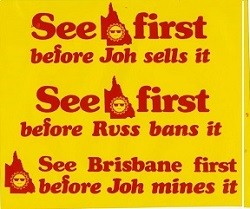
Australian Labor Party, 1977. Ephemera Collection, John Oxley Library, State Library of Queensland
In the same era a bumper sticker authorised by the Queensland Branch of the Australian Labor Party - sometimes dated in the following year but more probably produced to coincide with the 1977 election - was modelled on contemporary Queensland tourism campaigns. To our knowledge this expanded version of the popular See Qld first before Joh sells it sticker is not held in any other library institution.
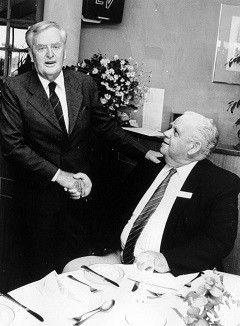
Russell Hinze with Sir Joh Bjelke- Petersen, 1989. John Oxley Library, State Library of Queensland. Neg 78920
The reference to Minister for Local Government Russ Hinze was most likely an allusion to his role in banning protest and street marches in September 1977 and it may also have referred, in a climate where Queensland’s strict censorship laws were being challenged by civil liberties groups, to his now famous (or infamous) characterisation of the Musical Hair as “a show for the sexually depraved, or a group of homosexuals, lesbians, wife-swappers and spivs”. The ALP at this point in history were also alluding to what they saw as the Premier’s disdain for environmental issues, especially where they were in conflict with government initiated mining contracts.
Go back – you are going the wrong way / Brisbane Freeway Protest and Compensation Committee 1974
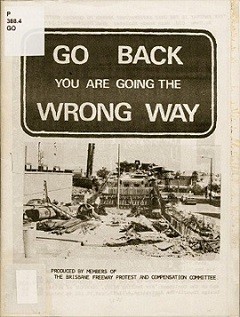
Go back you are going the wrong way / produced by members of the Brisbane Freeway Protest and Compensation Committee, c. 1974. John Oxley Library collection.
This booklet, produced in 1974 and now digitised by State Library, is one of three exhibition items devoted to freeway protest associated with the resumption of land in Brisbane suburbs by the Main Roads Department in the early seventies. The Brisbane Freeway Protest and Compensation Committee, established in late 1972, was part of a broader complex of anti-freeway and anti-development groups formed to lobby against what they believed were the excesses of urban expansion - and their overriding concerns were about the consequent loss of freedoms suffered by affected residents.
In St. Lucia a group of town planners, students and architects known as the Planning Action Group had formed with the intention of influencing planning schemes and offering their expertise to community groups. Resident action groups had sprung up to lobby against developments and issues such as the planned airport expansion on Cribb Island, pollution threatening Bulimba Creek and a $50 million development scheme planned for Samford Valley.
At the basis of the freeway related protest was a complex 154 kilometre road network and freeway system proposed for the Greater Brisbane Area in 1965 by Wilbur Smith and Associates (the Wilbur Smith Plan). The series of interlinking freeways across the inner city were intended to replace the tram networks which ceased to operate in 1969 and, taken to their conclusion, would have meant the forced acquisition of around 10,000 homes, many of which were owned by recent migrants and the elderly.
According to the Protest Committee, as at September 1974, approximately 13 kilometres of freeway had been completed: it followed that the particular focus of protest would be on those freeways approved for construction but still awaiting finance - the Central, Northern , Northwest and Centenary freeways and the Southwest Expressway.
The arguments mounted against freeway development were, unsurprisingly, about their impact on communities, their expense and their aesthetics. The detailed case against them points to their inability to solve congestion problems, the trauma caused to residents forced to relocate, the cost to the public purse, the squandering of energy resources, waste of valuable land, destruction of good housing, the consequent noise and their visual blight upon the city landscape. The alternative solutions proposed by the authors of Go Back are about upgrading and coordinating public transport systems, provision for bicycle traffic and the electrification of the rail system.
The case study highlighted in this publication is that of the Northern Freeway, planned to connect the Central Freeway in Bowen Hills with Gympie Road at Kedron. In 1972 the Main Roads Department published the first of three impact studies devoted to the Northern Freeway. The study areas include the section between Enoggera Creek and Kedron Brook taking in the suburbs of Windsor, Lutwyche and Wooloowin and the western areas of Albion, Mayne, Clayfield and Kalinga. The third study was not published until 1978.
In the context of anti-freeway protest, the Northern Freeway was a critical point of concern for lobby groups such as the Brisbane Freeway Protest and Compensation Committee who defended the interests of the elderly, tenants and powerless residents whose homes were to be resumed. It was also the subject of a “green ban”, the term coined to describe union based work bans on developments where an adverse community, heritage or environmental impact had been identified. The Building Trades Group of Unions, authors of the I stand on my record cartoon described earlier, placed “a demolition ban on every house in the way of the Northern Freeway” until such time as the State Government could adequately compensate and rehouse affected residents.
In the wake of demolitions and heated confrontation between police and protestors Northern Freeway plans were eventually abandoned, a critical factor being the Roads Grants Bills which gave the federal government the final say in relation to freeway developments. While the Whitlam Labor government was opposed to urban freeway systems such as this one, the Go back booklet predated the withdrawal of federal funding (committed until June 1974). Ultimately the combination of resident opposition, spiralling costs and the financial crisis of 1973 ended in the demise of the Northern Freeway proposal. All that remained of the Wilbur Smith Plan in fact were the South-East Freeway -which cut Woolloongabba in half- and a highly modified version of the Centenary Highway. More than three decades later, part of the corridor originally gazetted for the construction of the Northern Freeway would become the tolled Clem Jones (CLEM7) Tunnel which emerges close to Campbell Street in Bowen Hills.
The Battle for Bowen Hills: a film by Peter Gray and Garry Lane. 1982
In the more than four decades of development proposals and waves of community protest which have succeeded the high drama of the Northern Freeway protest, the original voices of that 1973 epic struggle might have been lost were it not for the iconic record captured so compellingly in The Battle for Bowen Hills. This 21 minute long documentary - which will be screened for the duration of the Freedom Exhibition - was pitched to community groups facing similar development proposals and it made a strong political statement about the necessity to defend the rights and freedoms of working class residents against powerful corporate and government interests. It also puts the case for increased spending on public transport - rather than freeway development - as a solution to road congestion.
The film, set in 1973-74 and taking a 1982 perspective, is essentially about the plight of a group of Bowen Hills residents whose homes were to be demolished to make way for the Northern Freeway. According to the construction plan it was at this point that the proposed Central and Northern freeways were to meet. To provide for a complex freeway interchange fourteen lanes of roadway were designed to run through Bowen Hills. The Main Roads Department acquired approximately 600 homes and businesses in Bowen Hills, taking in main residential areas, critical localities being Markwell Street (which was to be subsumed to make way for an overpass bridge), Hurworth and surrounding streets. The “battle” was fought not only to protect powerless residents against the enforced trauma of dislocation but to expose what was generally held to be the grossly inadequate compensation offered to them by the Queensland Government.
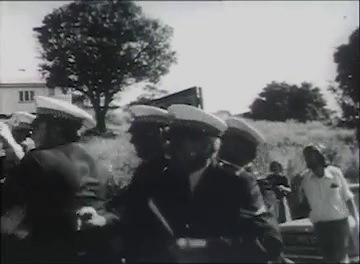
Excerpt from the documentary film "The Battle for Bowen Hills" by Gary Lane and Peter Gray, 1982. John Oxley Library collection.
The Bowen Hills community of the early seventies is described in the Go Back booklet as a tight knit one which included a significant percentage of Italian residents, elderly people and pensioners. A high proportion of them were long term residents who lived in older timber houses which were generally structurally sound and well maintained. Residents, many of whom did not own cars, were within walking distance of shops, public transport and social and medical facilities and had built a life in the community which was about to be profoundly destabilised.
The film speaks compassionately through the community voices of elderly resident Mary Tisdall, Italian Guilo Cerazani whose home was raided by federal police (in a quest for non-existent guns and ammunition) following his attempt to stop the demolished house next door from falling onto his property and through protest supporter Grace Kuhl. Their case is advocated for by both narrator Geraldine Willesee and the articulate and passionate activist Betty Hounslow.
The camera witnesses the demolition of local houses and registers the shocked grief on the faces of local residents. It shows what amounts to violent confrontation between baton wielding police and activists heckling the “scab” workers brought in to break union bans on demolition. It speaks of the acute housing shortage in Brisbane and shows the Government’s heavy handed response - in the form of a dawn raid by 50-60 police, sledge hammers, forced evictions and bulldozers - to protestors who attempted to occupy recently evacuated houses seized by the Main Roads Department.
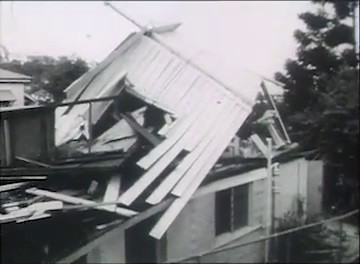
Excerpt from the documentary film "The Battle for Bowen Hills" by Gary Lane and Peter Gray, 1982. John Oxley Library collection.
In making the case for dramatically increased investment in public transport the camera provides aerial footage of vast expanses of an imposing Riverside Expressway and of traffic congestion on the Victoria Bridge. It then demonstrates how the Northern Freeway plan will take out ninety additional houses in working class localities in order to skirt the property occupied by the Queensland Newspapers Group, publishers of The Courier Mail. The documentary also includes a memorable close up interview with Main Roads Minister Russ Hinze in which he crystallises the polarised positions for and against public transport investment, describing members of the Brisbane Freeway Protest and Compensation Committee as “a pain in the neck” and as “fairies” who don’t live in the real world.
We learn at the end of the film that the only section of the Northern Freeway actually completed was a scaled down version of the overpass tunnel in Markwell Street. While a small number of houses were demolished - and the camera tracks over a desolate landscape of excavated earth, forsaken foundations and the sad vestiges of the lives once lived in them - Mary and Grace survived the development plan and were able to continue living in their own homes.
Free transport - not freeways: the Invaders: a Communist Party publication 1972
In an interesting intersection between two Exhibition sub-themes - On the road, in the air and A home of your own, a modest pamphlet authorised by C. (Charlie) Gifford for the Communist Party (Charlie, a Brisbane wharfie contested the federal seat of Brisbane in the same year) advocated for much the same issues, focusing in particular on what it described as “Brisbane’s transport crisis”.
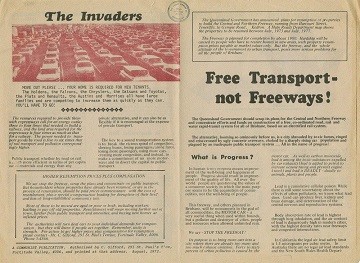
Free transport - not freeways : the invaders / Communist Party of Australia, 1972. John Oxley Library collection.
Communist Party interest in the freeway versus public transport argument was also invested elsewhere: membership of the Brisbane Freeway Protest and Compensation Committee, for instance, included Communist Party members along with University of Queensland based political activists and members of environmental and religious organisations. Within the Building Trades Group of Unions the Communist controlled Building Workers Industrial Union (BWIU) played a critical role in organising Northern Freeway green bans on houses targeted by Main Roads for demolition.
This pamphlet digitised by State Library with the support of the Search Foundation (whose role is to preserve the resources of the (original) Communist Party of Australia) questions the nature of a consumer society, along with the value of “progress” which doesn’t result in well-being and improved quality of life for the people. It addresses concerns similar to those informing the Go Back pamphlet and The Battle for Bowen Hills - the imperative for reasonable compensation for residents whose homes had already been resumed, the wasteful use of non-renewable resources, urban (and particularly lead) pollution resulting from the ever increasing use of the motor car, the inadequate state of the public transport system. It points to declining overseas interest in the freeway concept and accuses oil and motor industry corporate interests of profiting hugely from freeway projects at the expense of ordinary consumers.
Why are these exhibition items significant? Each, in some sense, might be generally categorised as belonging to an argument about development - its impact on people, the freedoms lost because of it and implicitly, the freedoms government agencies saw as constituting progress, an advance on the part of a consumer society. In the case of the last three exhibition items, the historical importance of the protest they speak of is that this is the first instance of co-ordinated, large scale freeway protest in Queensland. It foreshadows increasingly strong opposition to urban freeway projects over succeeding decades. And it reflects the dichotomy inherent in the very idea of freedom - my freedom to live in my home without fear of dislocation or loss of an aesthetic environment, your freedom to get somewhere in the shortest possible time, to be in one of those fast moving cars on an urban motorway.
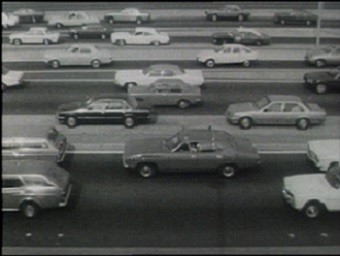
Excerpt from the documentary film "The Battle for Bowen Hills" by Gary Lane and Peter Gray, 1982. John Oxley Library collection.
Further reading:
Talk by Tom O'Brien, Secretary, Brisbane Freeway Protest & Compensation Committee to Trades and Labor Council on Wednesday 26th September ‘73 / Brisbane Freeway Protest & Compensation Committee, 1973.
Northern Freeway Impact Study : report no.1 / Queensland. Main Roads Department, 1972
Brisbane Northern Freeway impact study : social consequences : general report. No. 1, Residents and the Brisbane northern freeway : the pre-relocation situation / Patrick Mullins. St. Lucia, Qld. : Dept. of Anthropology and Sociology, University of Queensland, 1976
History of Brisbane's major arterial roads – a main roads perspective. Part 1 / Allan Krosch Queensland Roads Edition No 7 March 2009.
History of Brisbane's major arterial roads – a main roads perspective. Part 2 / Allan Krosch. Queensland Roads Edition No .8 March 2010.
Whose Green Bans? The Builders’ Labourers’ Federation, the Trade Union Movement and Green Bans in Queensland in the 1970s/ India Anderson. Centre for the Government of Queensland Summer Scholar Journal, 4, 2013-14
Libby Fielding - John Oxley Library, State Library of Queensland
Comments
Your email address will not be published.
We welcome relevant, respectful comments.